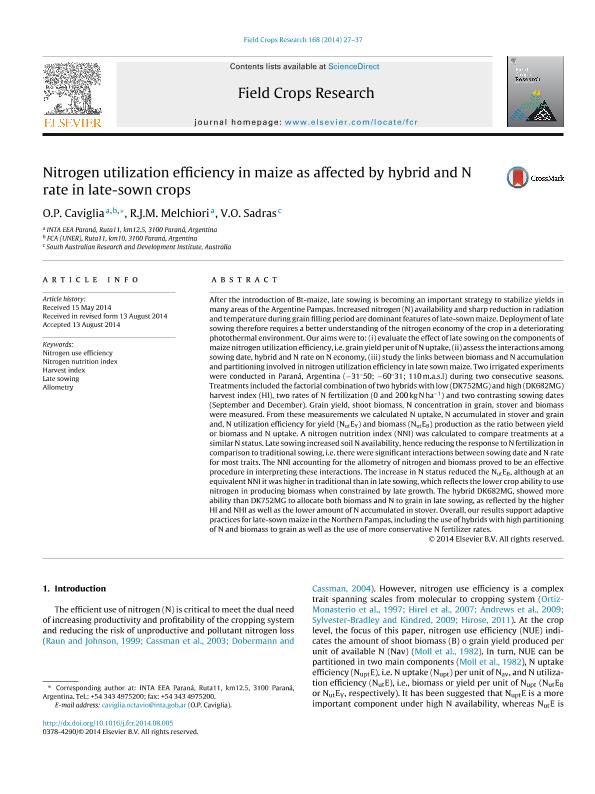Mostrar el registro sencillo del ítem
dc.contributor.author
Caviglia, Octavio Pedro

dc.contributor.author
Melchiori, R. J. M.
dc.contributor.author
Sadras, Victor Oscar

dc.date.available
2018-02-14T15:21:58Z
dc.date.issued
2014-11
dc.identifier.citation
Caviglia, Octavio Pedro; Melchiori, R. J. M.; Sadras, Victor Oscar; Nitrogen utilization efficiency in maize as affected by hybrid and N rate in late-sown crops; Elsevier Science; Field Crops Research; 168; 11-2014; 27-37
dc.identifier.issn
0378-4290
dc.identifier.uri
http://hdl.handle.net/11336/36426
dc.description.abstract
After the introduction of Bt-maize, late sowing is becoming an important strategy to stabilize yields in many areas of the Argentine Pampas. Increased nitrogen (N) availability and sharp reduction in radiation and temperature during grain filling period are dominant features of late-sown maize. Deployment of late sowing therefore requires a better understanding of the nitrogen economy of the crop in a deteriorating photothermal environment. Our aims were to: (i) evaluate the effect of late sowing on the components of maize nitrogen utilization efficiency, i.e. grain yield per unit of N uptake, (ii) assess the interactions among sowing date, hybrid and N rate on N economy, (iii) study the links between biomass and N accumulation and partitioning involved in nitrogen utilization efficiency in late sown maize. Two irrigated experiments were conducted in Paraná, Argentina (−31°50; −60°31; 110 m.a.s.l) during two consecutive seasons. Treatments included the factorial combination of two hybrids with low (DK752MG) and high (DK682MG) harvest index (HI), two rates of N fertilization (0 and 200 kg N ha−1) and two contrasting sowing dates (September and December). Grain yield, shoot biomass, N concentration in grain, stover and biomass were measured. From these measurements we calculated N uptake, N accumulated in stover and grain and, N utilization efficiency for yield (NutEY) and biomass (NutEB) production as the ratio between yield or biomass and N uptake. A nitrogen nutrition index (NNI) was calculated to compare treatments at a similar N status. Late sowing increased soil N availability, hence reducing the response to N fertilization in comparison to traditional sowing, i.e. there were significant interactions between sowing date and N rate for most traits. The NNI accounting for the allometry of nitrogen and biomass proved to be an effective procedure in interpreting these interactions. The increase in N status reduced the NutEB, although at an equivalent NNI it was higher in traditional than in late sowing, which reflects the lower crop ability to use nitrogen in producing biomass when constrained by late growth. The hybrid DK682MG, showed more ability than DK752MG to allocate both biomass and N to grain in late sowing, as reflected by the higher HI and NHI as well as the lower amount of N accumulated in stover. Overall, our results support adaptive practices for late-sown maize in the Northern Pampas, including the use of hybrids with high partitioning of N and biomass to grain as well as the use of more conservative N fertilizer rates.
dc.format
application/pdf
dc.language.iso
eng
dc.publisher
Elsevier Science

dc.rights
info:eu-repo/semantics/openAccess
dc.rights.uri
https://creativecommons.org/licenses/by-nc-sa/2.5/ar/
dc.subject
Nitrogen Use Efficiency
dc.subject
Nitrogen Nutrition Index
dc.subject
Harvest Index
dc.subject
Late Sowing
dc.subject
Allometry
dc.subject.classification
Agricultura

dc.subject.classification
Agricultura, Silvicultura y Pesca

dc.subject.classification
CIENCIAS AGRÍCOLAS

dc.title
Nitrogen utilization efficiency in maize as affected by hybrid and N rate in late-sown crops
dc.type
info:eu-repo/semantics/article
dc.type
info:ar-repo/semantics/artículo
dc.type
info:eu-repo/semantics/publishedVersion
dc.date.updated
2018-02-14T13:19:38Z
dc.journal.volume
168
dc.journal.pagination
27-37
dc.journal.pais
Países Bajos

dc.journal.ciudad
Amsterdam
dc.description.fil
Fil: Caviglia, Octavio Pedro. Universidad Nacional de Entre Ríos; Argentina. Instituto Nacional de Tecnología Agropecuaria. Centro Regional Entre Rios; Argentina
dc.description.fil
Fil: Melchiori, R. J. M.. Instituto Nacional de Tecnología Agropecuaria. Centro Regional Entre Rios; Argentina
dc.description.fil
Fil: Sadras, Victor Oscar. South Australian Research and Development Institute; Australia
dc.journal.title
Field Crops Research

dc.relation.alternativeid
info:eu-repo/semantics/altIdentifier/doi/http://dx.doi.org/10.1016/j.fcr.2014.08.005
dc.relation.alternativeid
info:eu-repo/semantics/altIdentifier/url/https://www.sciencedirect.com/science/article/pii/S0378429014002305
Archivos asociados
